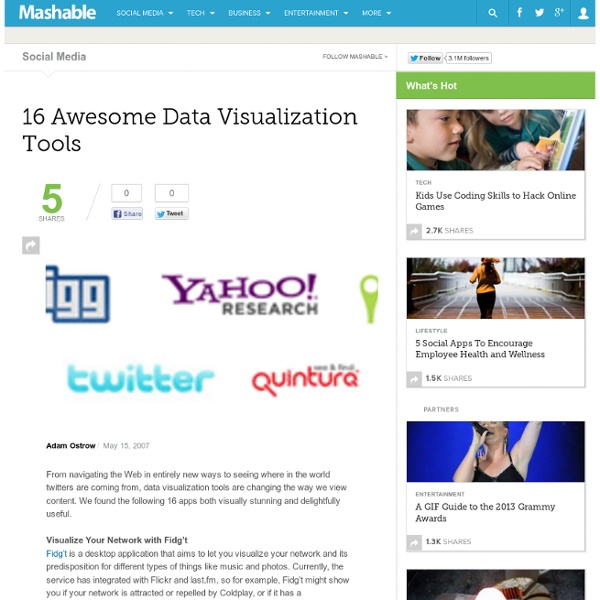Data Visualization: Modern Approaches - Smashing Magazine
How To Integrate Live Tweets Into Your Presentations
I’ve seen plenty of presentations that try to incorporate social media, polling, and other interactive tools. It’s all an effort to engage the audience and keep the conversation going. But usually these presentations don’t do it right. Lucky for you, we just stumbled across a new tool that’s designed to incorporate live tweets into your presentation. It’s called SAP Web 2.0 it’s as simple to use as PowerPoint. Using It In The Classroom SAP Web 2.0 could be a great way to encourage students to start / keep using Twitter. How will you use Twitter in the classroom? Screenshots
The Best Tools for Visualization
Visualization is a technique to graphically represent sets of data. When data is large or abstract, visualization can help make the data easier to read or understand. There are visualization tools for search, music, networks, online communities, and almost anything else you can think of. Whether you want a desktop application or a web-based tool, there are many specific tools are available on the web that let you visualize all kinds of data. Here are some of the best: Visualize Social Networks Last.Forward: Thanks to Last.fm's new widget gallery, you can now explore a wide selection of extras to extend your Last.fm experience. Last Forward Friends Sociomap: Friends Sociomap is another Last.fm tools that generates a map of the music compatibility between you and your Last.fm friends. Fidg't: Fidg't is a desktop application that gives you a way to view your networks tagging habits. Fidg't The Digg Tools: One more: Digg Radar. YouTube: Visualize Music Musicovery Last.fm music visual tools: Amazon
Datavisualization
Tools And Resources For Creating Infographics
Infographics. You have probably seen them before. There are so many out there on a wide variety of topics. Here are just a few. These really are a great way to visualize data. Here are a few of my favorite sites and tools to use when creating infographics. Wordle: Chances are this is one you have heard of. Visual.ly: It doesn't get much simpler than using Visual.ly. Stat Silk: This is a set of tools that you can download to create interactive maps and charts. Creately: Creatly is an online mindmapping program that is pretty powerful. Google Public Data Explorer: It probably goes without saying but Google has access to lots of data. Aviary Phoenix-Once you gather your images, charts and graphics, you are going to need a way to put them together. Kathy Schrock has an entire webiste dedicated to using infographics in the classroom. What other sites do you use to visualize data?
Open Data Services Open Left and Right
Where can I find a list of public hospitals along with their location data? I have the school performance statistics worldwide, so how do I share it with the rest of the world? These questions are being posed right now. So, gone are the days visualization addicts (like me...) had to be content with datasets that dealt with the weather, the stock market, and uhm... the weather. A lot has been happening in the "data" arena, lately. Public Data [publicdata.eu] has recently opened its virtual doors, as it attempts to rival to the US data.gov initiative in collecting all of Europe's Open Data (and not just governmental data). Get The Data [getthedata.org] is a more qualitative approach, as it aims to solve the many questions surrounding the aspects of finding and dealing with data. Data Market [datamarket.com] has launched a few weeks ago. Lastly, Google Public Data Explorer [google.com] is now open for anyone's data. So what are you waiting for?
10 Awesome Free Tools To Make Infographics
Advertisement Who can resist a colourful, thoughtful venn diagram anyway? In terms of blogging success, infographics are far more likely to be shared than your average blog post. This means more eyeballs on your important information, more people rallying for your cause, more backlinks and more visits to your blog. In short, a quality infographic done well could be what your blog needs right now. Designing An Infographic Some great tips for designing infographics: Keep it simple! Ideas for infographic formats include: Timelines;Flow charts;Annotated maps;Graphs;Venn diagrams;Size comparisons;Showing familiar objects or similar size or value. Here are some great tutorials on infographic creation: Creating Your Infographic Plan and research.If required, use free software to create simple graphs and visualisations of data.Use vector graphic software to bring these visualisations into the one graphic. Free Online Tools For Creating Infographics Stat Planet Hohli Creately New York Times Many Eyes Wordle
Free Data Visualization and Analysis Tools
What it does: Google Refine can be described as a spreadsheet on steroids for taking a first look at both text and numerical data. Like Excel, it can import and export data in a number of formats including tab- and comma-separate text files and Excel, XML and JSON files. Refine features several built-in algorithms that find text items that are spelled differently but actually should be grouped together. After importing your data, you simply select edit cells --> cluster and edit and select which algorithm you want to use. After Refine runs, you decide whether to accept or reject each suggestion. There are also numerical options that offer quick and easy overviews of data distributions. Beyond data housekeeping, Google Refine offers some useful analysis tools, such as sorting and filtering. What's cool: Once you get used to which commands do what, this is a powerful tool for data manipulation and analysis that strikes a good balance between functionality and ease of use. Impure Impure



